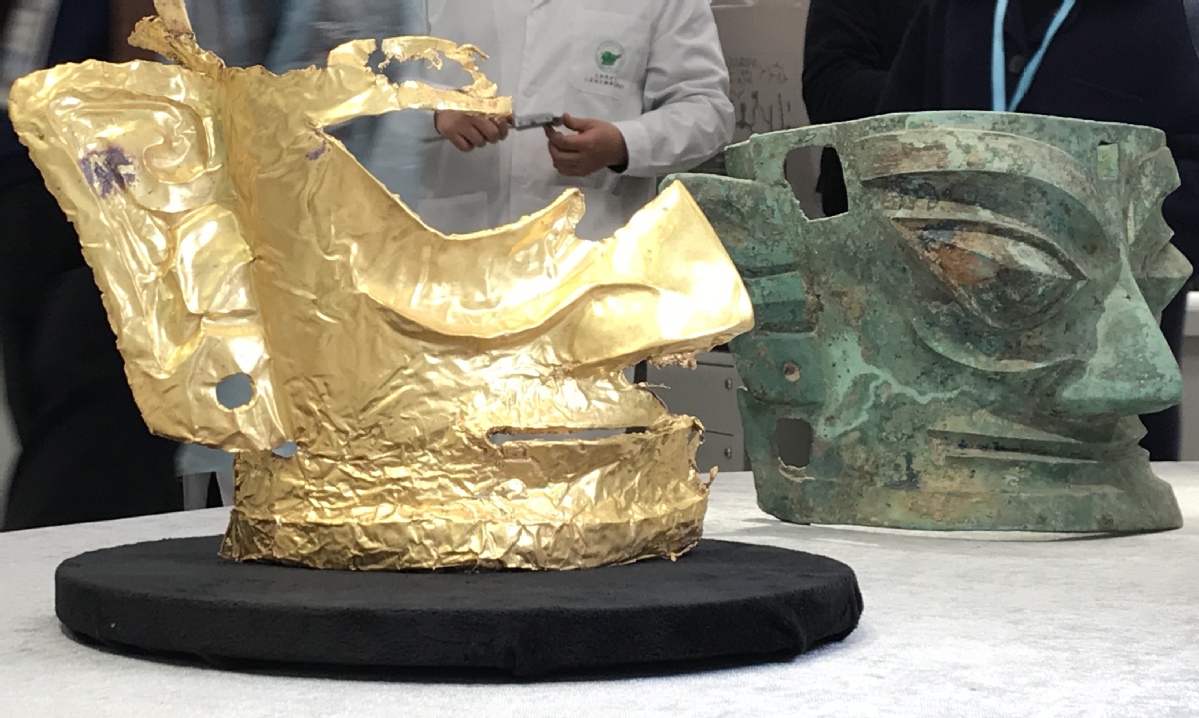周六,中国考古学家宣布在四川广汉三星堆遗址进行的挖掘中发现了500多件文物。
Chinese archaeologists announced the discovery of over 500 cultural relics on Saturday, during an ongoing excavation at the Sanxingdui Ruins site in Guanghan, Sichuan province.
这些文物被发现在六个祭祀坑,可追溯到3200多年前。
The relics were uncovered in six sacrificial pits which date back over 3,200 years.
其中重要的文物有金、铜面具、青铜器、100多颗象牙、纺织品和玉器等文物。
Among the important cultural finds are gold and bronze masks, bronze ware, more than 100 ivory tusks, textiles and jade among other artifacts.
负责此次发掘工作的四川省文物考古研究院研究员雷宇说:“由于有了新的发现,我们已经基本摸清了三星堆遗址祭祀区的布局。”。
"Thanks to the new discoveries, we've basically figured out the layout of the sacrificial zone of the Sanxingdui site," said Lei Yu, a researcher at the Sichuan Provincial Cultural Relics and Archaeology Research Institute who heads the ongoing excavation.
这个约12平方公里的遗址于1929年被发现,1986年取得重大突破,发现了两个用于祭祀仪式的坑。这些坑是当地农民挖土制砖时意外发现的。
The about 12-square-kilometer site was discovered in 1929, and major breakthroughs were made in 1986 with the discovery of two pits believed to be for sacrificial ceremonies. The pits were accidentally uncovered by local farmers digging up earth to make bricks.
当时发现的文物有1000多件,包括精心装饰的青铜器、面具和“神树”——树枝伸展的青铜器。
Over 1,000 artifacts were found at that time, including elaborately decorated bronze ware, face masks and "divine trees"-bronze sculptures of trees with stretching branches.
在向《中国日报》解释为何新一轮发掘在中断了几十年之后才到来时,雷政富说,此前对1号坑和2号坑的发掘是为了在意外发现后抢救文物。
Explaining to China Daily why the new round of excavations has come after a hiatus of decades, Lei said the previous excavations of pits No 1 and No 2 were made to rescue artifacts after the accidental discovery.
“一旦这两个坑被清理干净,进一步挖掘的紧迫性就不存在了,”他说考古学不能草率。我们必须等待一个精心规划的学术目的的需要,才能主动进行更多的发掘。”
"Once the two pits had been cleaned, the urgency for further excavation did not exist," he said. "Archaeology cannot be hasty. We have to wait for the need for a well-planned academic purpose to take the initiative for more excavations."
继一项旨在更深入了解四川蜀古文明的学术项目(该项目缺乏历史记录)之后,2019年10月,在1号和2号矿坑周围地区重新开始了调查。
Following an academic project aimed at more deeply understanding the ancient civilization in Sichuan province known as Shu, whose historical records are lacking, investigations in the area around the No 1 and No 2 pits were restarted in October 2019.
3号坑随后于2019年12月被发现。后续的实地研究于2020年3月开始,又发现了5个矿坑。10月,对所有6个坑进行了持续和详细的挖掘。
The No 3 pit was then found in December 2019. Follow-up field research began in March 2020, and five more pits were uncovered. In October, ongoing and detailed excavations were started on all six pits.
六个坑中最大的一个是8号坑,面积为19平方米。最小的5号,占地3.5平方米,是最近发现金面具的地方。
The biggest among the six pits, the No 8 pit, is 19 square meters. The smallest, No 5, which covers 3.5 sq m, is where the most recent gold mask was found.
雷指出,从出土文物的类型来看,最近发现的坑和1986年发现的两个坑有很多相似之处。神树和青铜面具再次被发现。
Lei pointed out there were many similarities among the more recently discovered pits and the two found in 1986, in terms of the types of artifacts unearthed. Divine trees and bronze masks were found once again.
最近的发现进一步证实了这一理论,即这些坑是用来祭祀的,因为发现的许多物品在被掩埋前都被砸碎并烧毁了。雷说,需要更深入的研究,以排除任何其他使用猜测。
The recent discoveries further confirm the theory that the pits were used for sacrificial purposes as many of the items found had been smashed and burned before being buried. Lei said that deeper study is needed to rule out any other speculation as to the pits usage.
